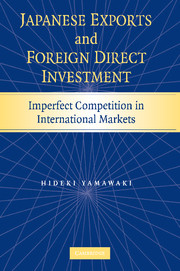Book contents
- Frontmatter
- Contents
- Tables
- Figures
- Preface
- 1 Introduction
- 2 Export Pricing Under Imperfect Competition
- 3 Export Price, Learning, and Domestic Demand Disturbances
- 4 Foreign Market Structure, Export Price, and Profitability
- 5 Competitive Advantage and Export Performance
- 6 Entry in the European and U.S. Manufacturing Industries
- 7 Strategic Interactions in Cross-Market Entry
- 8 Responses of Foreign Firms to Japanese Competition
- 9 Exit in the U.S. Manufacturing Industries
- 10 Interpreting the Empirical Findings
- 11 Implications
- Appendixes
- References
- Index
3 - Export Price, Learning, and Domestic Demand Disturbances
Published online by Cambridge University Press: 08 January 2010
- Frontmatter
- Contents
- Tables
- Figures
- Preface
- 1 Introduction
- 2 Export Pricing Under Imperfect Competition
- 3 Export Price, Learning, and Domestic Demand Disturbances
- 4 Foreign Market Structure, Export Price, and Profitability
- 5 Competitive Advantage and Export Performance
- 6 Entry in the European and U.S. Manufacturing Industries
- 7 Strategic Interactions in Cross-Market Entry
- 8 Responses of Foreign Firms to Japanese Competition
- 9 Exit in the U.S. Manufacturing Industries
- 10 Interpreting the Empirical Findings
- 11 Implications
- Appendixes
- References
- Index
Summary
Introduction
As shown in Chapter 3, Japanese firms were remarkably successful in penetrating the world export market of manufactured goods such as machinery, electrical equipment, electronics, and automobiles during the 1970s and 1980s. Although such export performance of Japanese manufacturing firms is greatly attributed to Japan's comparative advantage in capital-intensive and skill-intensive manufacturing and Japanese firms' competitive advantages in manufacturing practices and organizational capabilities (Chapter 10), the pricing behavior of Japanese firms was often criticized for allegations of dumping. Numerous cases of dumping were filed in the U.S. and European markets against Japanese products such as television sets, steel products, telephone equipment, electronic components, and office equipment throughout this period. Such dumping allegations did not necessarily infer Japanese firms' engagements in dumping in the subsequent antidumping suits, they suggest that Japanese firms show a high propensity to cut export price occasionally in the foreign market. This chapter, therefore, asks a question of what motivates Japanese firms to lower prices frequently in the export market.
The classic theories of dumping argue that dumping occurs when a firm with monopoly power that can segregate the home from foreign markets maximizes profits by discriminating prices in the two markets (Viner, 1923; Yentema, 1928; Robinson, 1933; Haberler, 1937). In this literature, dumping is regarded as monopolistic price discrimination between the home and foreign markets based on the underlying difference in the demand conditions of the two markets.
- Type
- Chapter
- Information
- Japanese Exports and Foreign Direct InvestmentImperfect Competition in International Markets, pp. 43 - 59Publisher: Cambridge University PressPrint publication year: 2007



